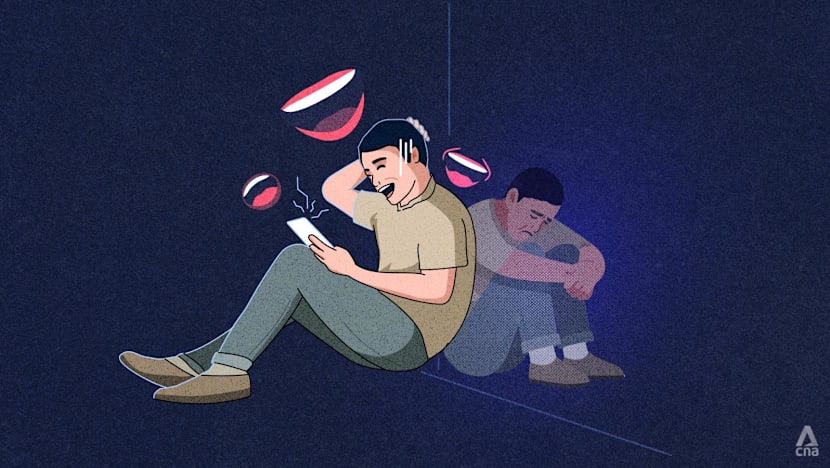Entertainment
Dark Humour on Social Media: Coping Mechanism or Masking Pain?

A recent trend on social media showcases individuals using dark humour as a means of expressing emotional struggles. Videos and memes that address serious topics—such as depression, self-harm, and existential distress—are proliferating online. This phenomenon invites questions about whether such humour serves as a coping mechanism or if it obscures deeper issues that require attention.
Understanding Dark Humour’s Rise
Dark humour has long existed as a psychological tool. As early as 1927, renowned psychoanalyst Sigmund Freud described humour as a protective mechanism for individuals facing painful realities. This type of humour enables people to endure difficult situations, as evidenced by historical examples. During the Nazi occupation in the 1940s, Czech citizens used gallows humour to undermine their oppressors. In contemporary hospital wards, cancer patients often make light of their mortality to alleviate tension.
What has evolved is not the concept of dark humour itself, but its accessibility. In an age dominated by digital communication, this form of humour has gained visibility, particularly among younger generations. Professor Crystal Abidin from Curtin University describes the phenomenon as social steganography, where shared cultural references create a dual meaning. Outsiders may perceive despair in these jokes, while insiders understand them as expressions of shared experience.
The current cultural landscape further amplifies this trend. Professor Abidin notes that today’s youth are exposed to a barrage of distressing news—ranging from wars to personal updates—leading to a blending of serious concerns with everyday life. Dark humour allows individuals to push back against societal pressures to present an ideal life online. This form of humour has become a way for people to compete in their suffering, sharing their challenges in a less daunting manner.
The Generational Divide in Humour
While older generations often delineate clear boundaries regarding acceptable topics for jokes, many young adults view dark humour as a shorthand for discussing complex feelings. Stella Ong, a clinical counsellor at LightingWay Counselling & Therapy, observes that her younger clients frequently use internet memes to articulate their emotional struggles with surprising nonchalance. This generational gap can lead to misunderstandings, as parents may misinterpret cryptic social media posts by their children as cries for help, when they are often expressions of shared experience.
Several factors contribute to the prevalence of dark humour. James Chong, principal counsellor at The Lion Mind, identifies situational stressors—such as academic pressure, job uncertainty, and the pervasive nature of social media comparisons—as catalysts for this humour. It serves as a release valve for individuals seeking to vent under increasing pressures, allowing them to navigate their emotions without risking awkwardness or heaviness.
Research indicates that individuals who are more creative and open, as well as those with higher education levels, are more likely to engage with dark humour. However, personal experiences with trauma do not necessarily dictate one’s propensity for morbid jokes. For some, distance from an issue makes humour easier, while for others, it serves as a survival tactic. As Mr. Chong explains, “If I can laugh at it, it has less power over me.”
Potential Pitfalls of Dark Humour
When employed effectively, dark humour can be a powerful coping mechanism. It allows individuals to acknowledge their pain while simultaneously finding levity in challenging situations. Ms. Ong notes that dark humour enables people to hold two realities at once: “I can laugh about this and acknowledge that it hurts.” This duality fosters solidarity and connection among those experiencing similar struggles.
Nevertheless, there are risks associated with overusing dark humour. It can hinder genuine expression of distress and potentially damage relationships. Ms. Ong warns that when dark humour becomes a barrier rather than a bridge, it may prevent individuals from seeking help. When humour consistently distances individuals from their pain, it can lead to a numbing effect. According to Dr. Roy Chan, a consultant clinical psychologist, excessive reliance on dark humour can normalize distressing situations, dulling emotional responses to triggers.
Moreover, when dark humour backfires, it can leave individuals feeling worse rather than lighter. Mr. Chong cautions that this reliance can shape one’s identity negatively, leading to perceptions of hopelessness. For some, the continuous negativity can become draining to those around them, making authentic connection more difficult. In professional settings, dark humour may be misinterpreted as a lack of professionalism or hostility.
Finding Balance in Dark Humour
The key to using dark humour effectively lies in balance. Rather than questioning whether dark humour should be used, it is crucial to evaluate whether it helps individuals connect more authentically with life. Ms. Ong suggests self-awareness as a guiding principle. She encourages individuals to ask themselves three questions to assess the impact of their humour: Does this humour create distance? Does it lead to discouragement? Does it disempower me?
Those concerned about friends or loved ones should approach the topic with curiosity rather than judgment. Mr. Chong recommends creating a safe space for the conversation, indicating empathy and openness. A simple inquiry like, “I’ve noticed you’ve been expressing feelings of hopelessness. Are you okay?” can make a significant difference.
Ultimately, dark humour can serve as a bridge that alleviates life’s burdens, but it can also become a barrier to healing. Understanding when humour is a coping strategy versus when it becomes counterproductive is essential for maintaining emotional well-being.
-

 Lifestyle3 months ago
Lifestyle3 months agoHumanism Camp Engages 250 Youths in Summer Fest 2025
-

 Sports3 months ago
Sports3 months agoDe Minaur Triumphs at Washington Open After Thrilling Comeback
-

 Business4 months ago
Business4 months agoKenvue Dismisses CEO Thibaut Mongon as Strategic Review Advances
-

 Sports4 months ago
Sports4 months agoTupou and Daugunu Join First Nations Squad for Lions Clash
-

 Top Stories4 months ago
Top Stories4 months agoColombian Senator Miguel Uribe Shows Signs of Recovery After Attack
-

 World4 months ago
World4 months agoASEAN Gears Up for Historic Joint Meeting of Foreign and Economic Ministers
-

 Business4 months ago
Business4 months agoOil Prices Surge Following New EU Sanctions on Russia
-

 Entertainment3 months ago
Entertainment3 months agoDetaşe-Sabah Violin Ensemble Captivates at Gabala Music Festival
-

 Health3 months ago
Health3 months agoNew Study Challenges Assumptions About Aging and Inflammation
-

 Entertainment3 months ago
Entertainment3 months agoBaku Metro Extends Hours for Justin Timberlake Concert
-

 Business4 months ago
Business4 months agoU.S. House Approves Stablecoin Bill, Sends to Trump for Signature
-

 Top Stories4 months ago
Top Stories4 months agoRethinking Singapore’s F&B Regulations Amid Business Closures









